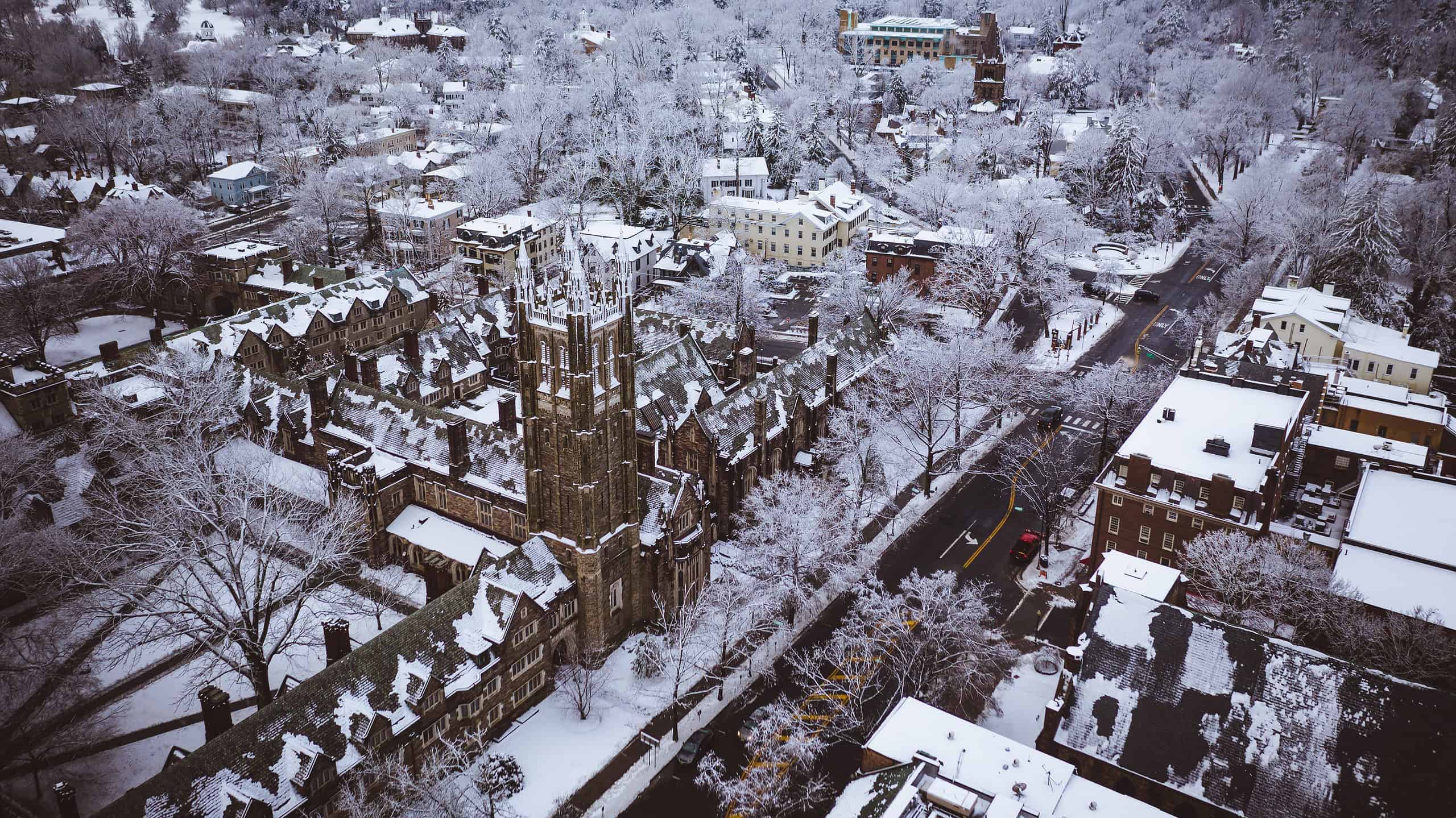From March 12 to 14, 1993, The Garden State experienced its biggest snowstorm ever. The “Storm of the Century” would be remembered for years. Strong winds and heavy snowfall blanketed large sections of the state, causing significant disruption to daily life and bringing transportation services to a standstill. Despite the challenges posed by this extreme weather event, New Jerseyans showed resilience and strength. They came together to face the storm head-on. In this article, we’ll look at what made this particular snowstorm unique. Let’s get right into the biggest March snowstorm in New Jersey history.
What Is the Typical Weather for the State of New Jersey During March?
It is in March that New Jersey experiences a transitional weather pattern. As winter approaches its end and spring begins to set in, the state generally encounters a mixture of cool, breezy days and mild, sunny ones.
In specific, the average high temperatures within this period range from the mid-to upper-40s°F (7-9°C). The average low temperatures range from the mid-20s°F (-4°C) in the northern part of the state to the low-30s°F (0°C) in the southern region.
Moreover, March is a relatively wet month for New Jersey, with approximately 4 inches of precipitation falling throughout the state. This precipitation may come in rain, snow, or a combination of both, contingent upon the temperature and other atmospheric conditions. Although snowfall is expected this month, it does not usually amass significant amounts, with an average snowfall of approximately 3 inches throughout the state.
All in all, the weather patterns in March can be unpredictable and differ from year to year.
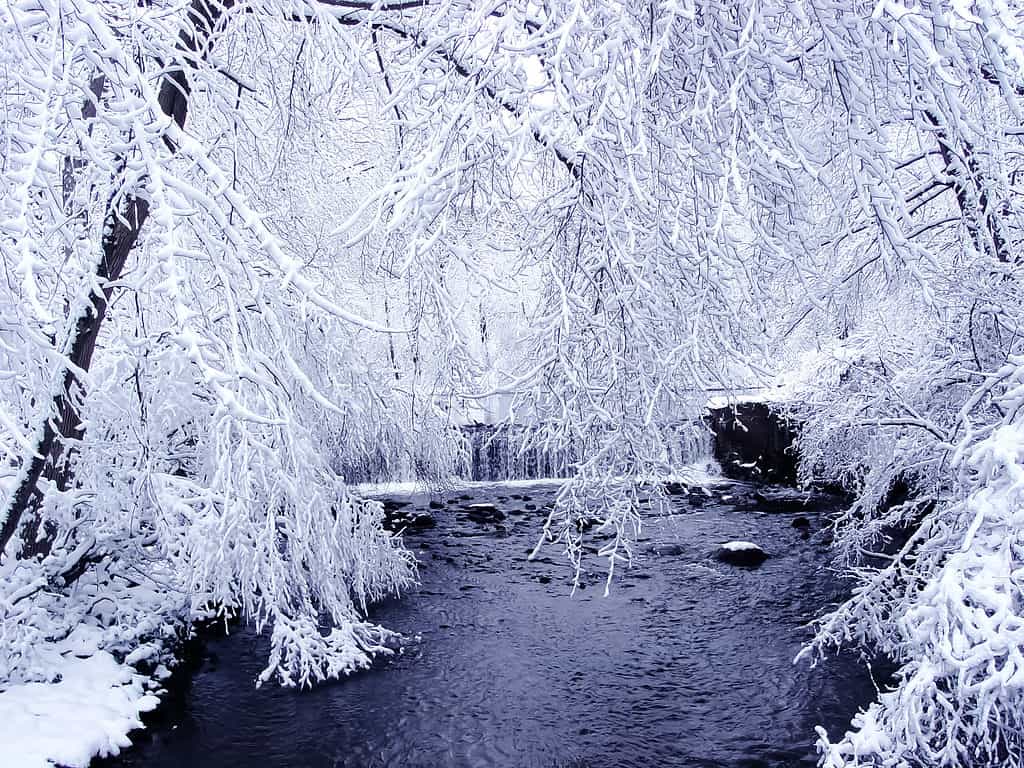
Snow in Butler, New Jersey. In New Jersey, the weather patterns in March can be unpredictable and differ from year to year.
©Wollertz/Shutterstock.com
What Was the Biggest Snowstorm to Ever Hit New Jersey During March?
The March 1st snowstorm of 1993 was one of the most memorable storms ever to hit the Garden State. The winter storm brought 10 to 20 inches of snowfall. The fierce blizzard lasted over 12 hours, with gusts of wind reaching up to 80 mph. This was an incredibly intense event for New Jerseyans. In fact, it came on the heels of a warmer-than-usual February and took many by surprise. As a result, the storm caused significant disruption to daily life. It also brought transportation services to a standstill while dumping nearly two feet of snow in some parts of the state.
Despite all this hardship, The Garden State showed tremendous resilience in responding to this historic storm. The National Guard assisted those still stranded by snow buildup. Utility companies worked around the clock to restore power outages across New Jersey. Community members also banded together in support, providing food and other essential items for those affected by the event. Thus, they demonstrated how strong we can be when faced with extreme weather events like this one.
How Did the Snowstorm Affect Residents Living in the State?
The Biggest March Snowstorm in New Jersey History was an unprecedented event for the state. It disrupted daily life and caused significant destruction to homes and businesses. But it wasn’t only physical damage that this storm caused. It also had a tremendous emotional impact on its residents. Here are some of the sectors that were largely affected.
Economy
The Biggest March Snowstorm in New Jersey History significantly impacted the state’s economy. Businesses, especially those in the northern parts of the state, were forced to close down due to road closures and power outages. Even when roads reopened and electricity was restored, many businesses suffered considerable losses due to a lack of access to customers and supplies.
In addition, many residents found themselves without jobs during the storm as companies were forced to lay off or furlough workers. This was because of lower demand from consumers and difficulties getting products and materials delivered on time. This disruption in employment created an economic ripple effect throughout the entire state. In fact, it impacted businesses that relied on employees spending their wages at local establishments like restaurants and shops.
Electricity
The March snowstorm of 1993 significantly impacted electricity in New Jersey. Heavy snow caused power lines to malfunction in many areas. It left thousands without access to necessary electricity for up to twelve hours or more. With temperatures falling below 10°F throughout the state during this storm, the lack of power made it especially difficult for households and businesses to stay warm.
Utility companies worked hard during and after the storm to repair downed power lines and restore electricity to affected areas. This was a massive undertaking given the amount of damage caused by the blizzard. However, they successfully restored power to most — though not all — of those who lost it due to the storm. Some people remained without power for several days following the storm due to the scope of destruction by the heavy snowfall and powerful winds.
Transport
Transportation in the state was also significantly impacted by the storm. Major highways and roads were closed, and public transport, including buses and trains, were temporarily suspended. This left many commuters stranded and unable to travel to work or school. Emergency services, such as police, firefighters, and medical personnel, also experienced significant difficulties reaching those in need.
Mental Health
Beyond its physical destruction, the Storm of the Century had a profound psychological impact on those in its path. With no time to prepare for such an extreme event, many people felt helpless as they watched their livelihoods be put in danger – not just from the blizzard itself but from its long-term consequences. Even with all of our modern advancements here in 2023, there’s still something frightening about being unable to control or predict when extreme weather events occur. Mother Nature can still surprise us even when we don’t expect it.
In the aftermath of the storm, New Jersey implemented measures to improve its ability to handle severe winter weather. The state increased the number of snowplows and stocked up on emergency supplies, such as generators and heating fuel. Residents were also encouraged to prepare for future storms by creating emergency kits and developing evacuation plans.
How Do Late-Season Snow Storms Impact Wildlife in the New Jersey Area?
Late-season snowstorms in the New Jersey area can significantly impact local wildlife. During this time of year, many species of animals are emerging from their winter hibernation or preparing for migration. This makes them more vulnerable to sudden changes in weather conditions.
The heavy snow and cold temperatures can make it difficult for wildlife to find food and water. This can lead to malnourishment and dehydration, particularly detrimental to young or weak animals. Moreover, the snow can make it challenging for some animals to move around, increasing their risk of predation or injury.
The impact of late-season snowstorms on wildlife can be particularly strong in areas where habitat loss and fragmentation have already reduced available resources. In these cases, the storm can exacerbate existing pressures on wildlife populations, leading to further declines in numbers.
Amid these late-season snowstorms, some species of wildlife have evolved to cope with these conditions. For example, certain bird species can switch to feeding on berries and other fruits when insects are scarce. Some mammals, such as squirrels and chipmunks, have adapted to store food for the winter months.
Where Did the Animals Go Amid the Snow Storm?
This storm caused immense disruption to food chains and habitats, resulting in significant distress for both animals and people.
In this section, we’ll explore how the storm affected different species — from their struggle to survive amidst heavy snowfall to their efforts at recovery afterward. We’ll also look at where animals go when faced with a severe winter weather event like this one. We’ll also mention what to do to protect them during such times.
Raccoons
Raccoons were among the most affected species in the wake of The Biggest March Snowstorm in New Jersey History. With their natural habitats covered by deep snow, many raccoons were left unable to forage for food or access suitable shelter. In response, these animals had to adapt to their new environment. They found creative ways to source sustenance and protect themselves from the cold. This included scavenging through snow-covered garbage cans, digging through the thick layers of snow in search of stored food sources, and huddling together in burrows or hollow trees for warmth.

Raccoons were among the most affected species in the wake of The Biggest March Snowstorm in New Jersey History.
©Laurascudder – Public Domain
Opossums
Opossums experienced difficulties in the wake of the biggest March Snowstorm in New Jersey history. With their natural ranges blocked off by deep snow, opossums could not access food sources or find suitable shelter. That left them vulnerable to hypothermia and other snow-related ailments. As a result, these animals were forced to find new and inventive ways to survive. For example, they raided bird feeders in suburban areas for sustenance and used porches or garages as shelters.

Opossums had to find new and inventive ways to survive during the biggest March snowstorm in New Jersey history.
©Cody Pope / CC BY-SA 2.5, via Wikimedia Commons – Original / License
Squirrels
Squirrels were significantly affected by the 1993 March snowstorm in various ways. This species became unable to access their typical food sources, such as nuts and berries. They had to find other sources of sustenance or risk starvation. To make matters worse, the deep snow hampered their ability to climb trees and access their stored caches of food. Consequentially, many squirrels turned to scavenging bird feeders or rummaging through garbage cans in search of sustenance.
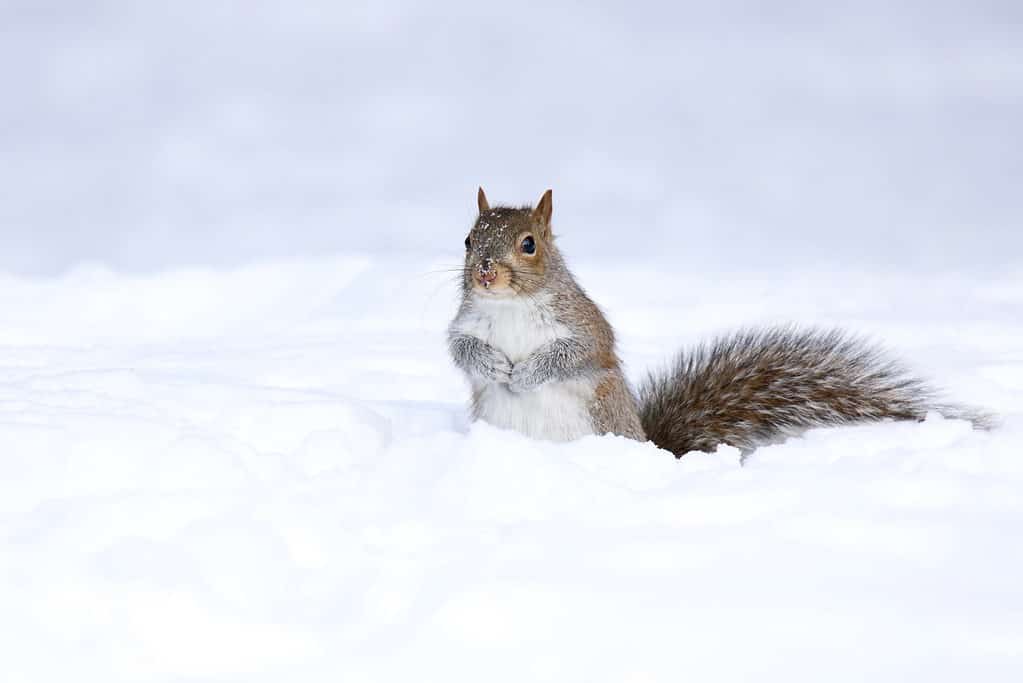
Squirrels became unable to access their typical food sources, such as nuts and berries.
©iStock.com/suefeldberg
Horses
Horses faced unique challenges due to the heavy snow and strong winds. Many horse owners took measures to protect their animals. For example, they provided extra feed and hay and ensured that their stables were well-insulated. Regardless of these efforts, horses still faced difficulties during the storm, including limited mobility due to deep snow and problem accessing water sources that had frozen over.
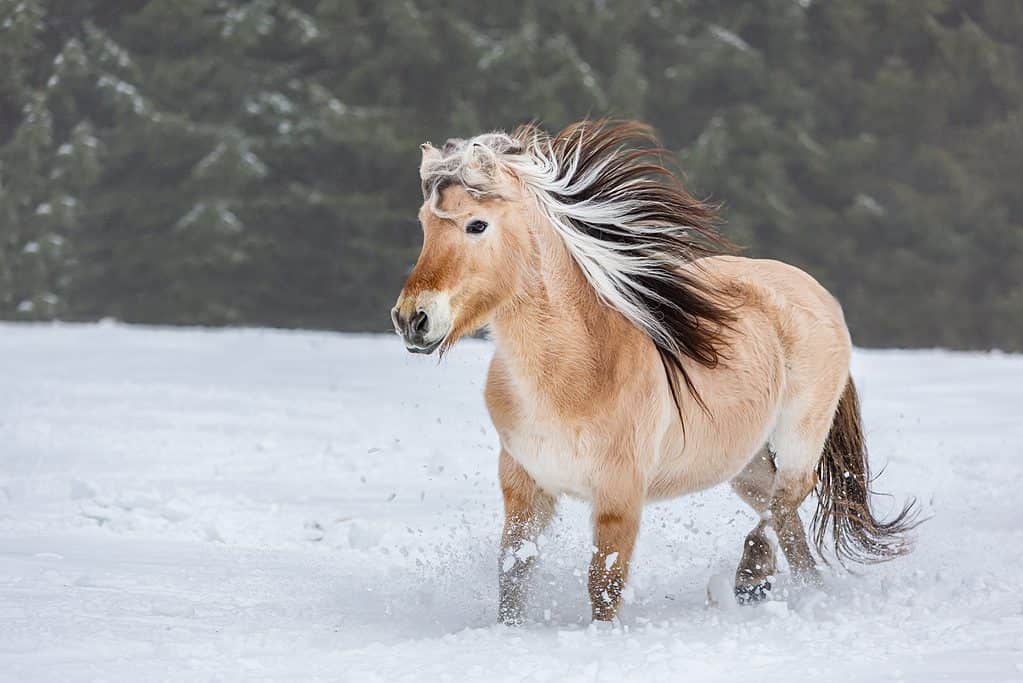
Many horse owners took measures to protect their animals during the 1993 Snowstorm.
©Annabell Gsoedl/Shutterstock.com
Birds
Birds were among the most affected species during The Biggest March Snowstorm in New Jersey History. In fact, these creatures rely on open areas, such as fields and forests, for sustenance. With their natural feeding grounds covered by snow, many birds experienced difficulty locating adequate nutrition and faced the prospect of starvation. In addition, many species had difficulty flying due to the extreme cold and heavy snowfall. Conservationists and birdwatchers worked to provide supplementary food sources such as bird feeders to help birds survive.
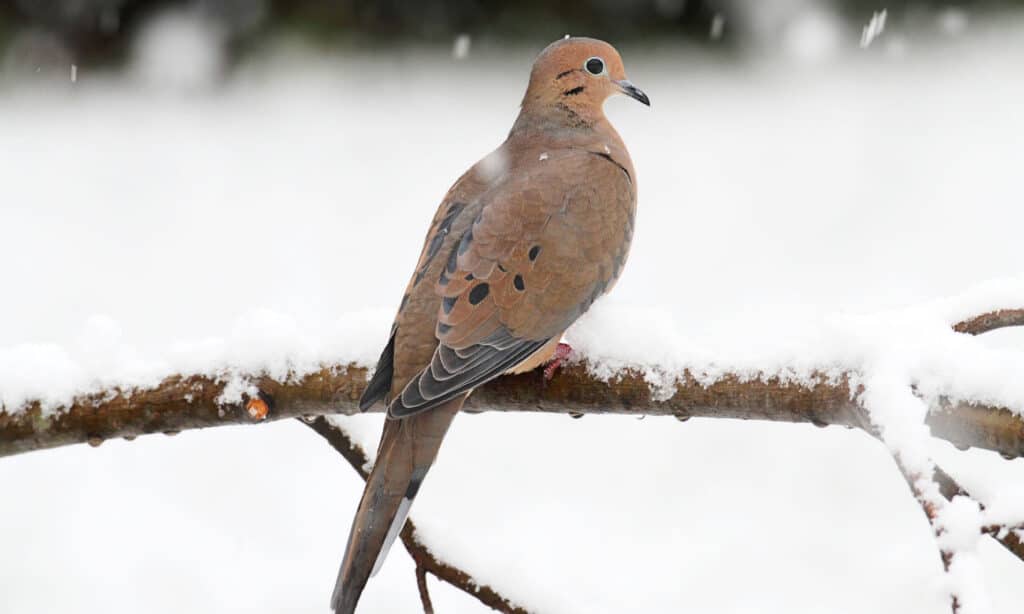
With their natural feeding grounds covered by snow, many birds experienced difficulty locating adequate nutrition and faced the prospect of starvation.
©iStock.com/SteveByland
Freshwater Fish
Freshwater fish were severely affected by The Biggest March Snowstorm in New Jersey History. With their ordinarily shallow bodies of water covered by a thick layer of snow, many species of fish had difficulty accessing shelter and adequate nutrition. This left them vulnerable to freezing temperatures and potential predators. In response, conservationists and anglers created additional feeding sources and warm refuges in deeper bodies of water. Furthermore, they made sure that any melted snow was draining away from freshwater habitats as quickly as possible to reduce the risk of flooding. Most species were able to make a steady recovery thanks to the hard work and dedication of local conservationists.
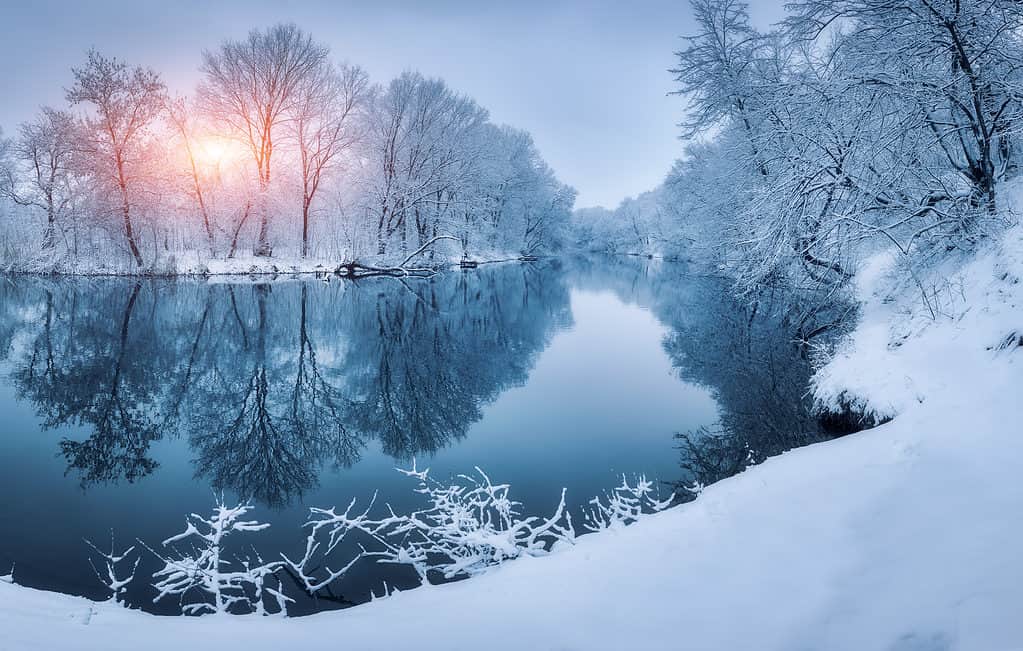
With their ordinarily shallow bodies of water covered by a thick layer of snow, many species of fish had difficulty accessing shelter and adequate nutrition.
©iStock.com/den-belitsky
Bottom Line
The Snowstorm of the Century was among the worst to hit the Garden State in history. Residents suffered heavy winds, deep snow, and freezing temperatures that wreaked havoc on humans and wildlife. With up to 20 inches of snow blanketing the ground in some parts of the state and sustained wind speeds reaching over 80 mph, many residents were left without power and access to necessities.
The storm caused significant damage to properties throughout the state, with thousands of homes suffering from flooded basements, collapsed roofs, and downed trees. Wildlife habitats were also impacted, as the drastic temperature changes and heavy snowfall disrupted fragile ecosystems.
Despite these challenges, the residents of New Jersey demonstrated remarkable resilience. Neighbors came together to help each other shovel snow, clear roads, and check on those particularly vulnerable, such as the elderly or disabled. Volunteers distributed food and supplies to those in need, and emergency responders worked around the clock to ensure the safety and well-being of residents.
The March snowstorm of 1993 brought considerable disruption to New Jersey’s residents and ecosystems. Still, it also served as an important lesson in resilience, one that we can use as we continue to face the effects of climate change today. By taking proactive steps to prepare for severe weather events, we can help ensure that our communities are equipped to withstand whatever Mother Nature throws their way.
Thank you for reading! Have some feedback for us? Contact the AZ Animals editorial team.

